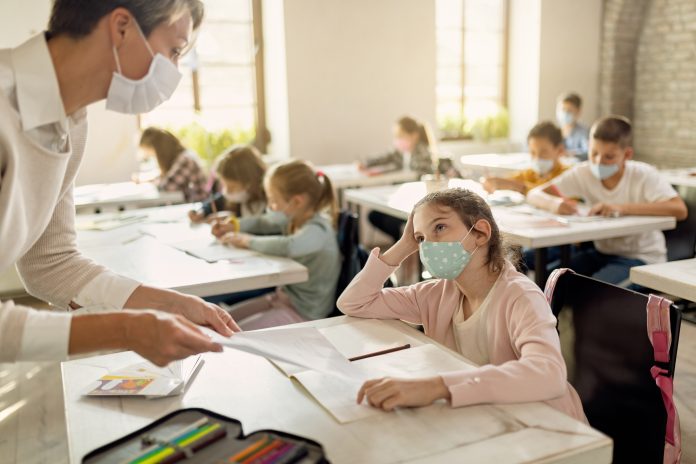Last week [Friday, January 7, 2022], the U.S. Supreme Court heard arguments over whether it should stay OSHA’s mandate for large employers, which went into effect on January 10, and will require 84 million Americans to either become vaccinated or submit to masking and weekly COVID testing. Through circuitous legal logic, that mandate would only apply to about half the nation’s teachers, and of those, about half already operate under similar vaccination requirements. Despite the limited direct impacts, the mandates indirect impacts on the nations’ schools could be dramatic.
Issued on November 5 as an emergency temporary standard, (ETS) the OSHA mandate threatened hefty fines for all employers with more than 100 employees who did not begin meeting the above requirements by January 4, 2022. A week later, a New Orleans appeals court stayed the mandate, calling it “staggeringly overboard,” and a month later the stay was lifted, allowing the mandate to proceed. The U.S. Supreme Court took the unprecedented step of scheduling oral arguments on the mandate while lower courts were still weighing the matter. In response, OSHA delayed enforcement until January 10 and enforcement of vaccination or testing requirements until February 9.
Though not targeted at schools, the mandate—and the Court’s potential action—will have large direct and potentially larger indirect impacts on the nation’s schools. Since teachers are the employees of districts, not individual schools, and since most school districts have over 100 employees, roughly 95 percent of public school teachers fit under the minimum employer size threshold. Despite this, only 24 states are under OSHA’s direct authority. Ironically, these teachers are not affected by the mandate. For states under OSHA’s direct authority, the term “employer” does not include state and local governments, excluding public school teachers and staff.
The remaining 26 states are not under OSHA supervision because they already have OSHA-approved state health and safety plans. However, those plans must be “at least as effective” as OSHA’s standards, and must include state and local government employees. Oddly enough, only teachers in states under their own state occupational and safety authority would be subject to the OSHA mandate. Of these, 9 states already have similar mandates in place, so the mandate would only change practice in 17 states, or for about a quarter of the nation’s teachers.
However, a nationwide change for large employers will shift the landscape of vaccination requirements. Districts in the 24 states whose public schools are not directly affected by the mandate would still see all their neighboring large employers adapt to the OSHA mandate. In areas where such policies shift from being unheard of to being the new normal, public and even private school leaders who are currently on the fence about requirements could be far more likely to embrace them. Since these indirect effects could reach across the country, they could cause more widespread changes than direct effects.
While the potential effect on schools is substantial, the likelihood that the mandate survives the Courts’ scrutiny may be less so. Last Friday, opponents argued that the mandate is an overreach of OSHA’s authority, and that such mandates should be left to states and employers, not the executive branch. Moreover, challengers questioned the scope of an “economy wide” mandate that exceeded OSHA’s typical industry-specific regulations. The challengers’ logic seemed to be that the Biden administration, without Congressional support for such a mandate, was pushing their preferred COVID mitigation plan using the strongest administrative lever available to them: OSHA.
The Administration, meanwhile, argued that when Congress created OSHA, it granted sufficient authority to issue this kind of ETS. They argue COVID is a grave threat in the workplace, that OSHA not only has the authority, but the responsibility to provide for workers’ safety, and that the mandate is therefore necessary.
In oral arguments, the conservative majority on the court seemed skeptical of the mandate. Justice Alito suggested the administration was trying to “squeeze an elephant through a mouse hole,” and conservative justices’ questions returned repeatedly to the scope of the mandate, and whether it fit within the authority Congress invested in OSHA.
The courts three liberal justices focused on the mandate’s public health benefits. Justice Breyer stated that it would be “unbelievable that it would be in the public interest to stop these vaccinations.”
Perhaps the most fundamental question concerned federal authority, or, as Justice Gorsuch put it, “Who decides.” Gorsuch, Kavanaugh, Barrett, and even Roberts, all hinted that the ETS may go beyond the Executive branch’s constitutional authority.
If the court issues a stay, which seems likely, it would effectively halt the mandate and schools could revert to their preexisting policies. The administration could have a path forward with a narrower OSHA regulation but it is unlikely that public schools would remain targets in that case.
If no stay is issued, the mandate will remain and directly impact school districts in the 26 states with state-plans, 17 of which do not currently have similar requirements. Private schools everywhere with more than 100 employees would also be affected.
The potentially greater indirect effects might take longer to play out. All large employers would be subject to the requirements in coming weeks. Schools and districts could be influenced over time by the normalization of vaccination requirements, and the net effect on schools nationwide could be profound.
We will likely receive the court’s ruling this week. Their decision on a mandate that directly affects half of schools could in fact have significant ramifications across the U.S. education system.
[On Thursday, January 13, 2022, by a 6–3 vote, the Supreme Court prevented the implementation of an OSHA rule that would have imposed a vaccine-or-testing regime on employers with 100 or more employees.-Ed. Note]Nat Malkus is a senior fellow and the deputy director of education policy at the American Enterprise Institute.
Originally published by RealClearPolicy. Republished with permission.









[…] post Without a Supreme Court Stay, the New OSHA Mandate Could Have Huge Indirect Effects on Schools appeared first on Heartland Daily […]